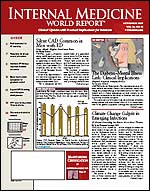Publication
Article
Internal Medicine World Report
Awaiting JNC-8, Revised Classification of Hypertension Offers Practical Pointers
Awaiting JNC-8, Revised Classification of Hypertension Offers Practical Pointers
By Laura Brasseur
In anticipation of JNC-8 (Joint National Committee on Prevention, Detection, Evaluation, and Treatment of High Blood Pressure), the hypertension writing group (HWG), which offered a new definition of hypertension during the annual meeting of the American Society of Hypertension (ASH) and was discussed in this journal in July 2005, have now published the details of their new classification in the Journal of Clinical Hypertension (2005;7:505-512), refocusing their treatment goals.
“Our classification amplifies the JNC 7 definition [Table 1],” write Thomas D. Giles, MD, president of ASH, and colleagues. “We afford even greater priority to risk factors and early markers of cardiovascular disease, target organ damage, and overt cardiovascular disease than to observed blood pressure patterns” (Table 2).
The HWG describes previously published blood pressure (BP) cut points as “a moving target,” tracing the history of the diagnostic criteria for hypertension from a pre-1984 diastolic BP of >105 mm Hg to the latest JNC 7 publication, which introduced the category of “prehypertension.”
HWG quarrels with the idea of “assigning an illness diagnosis” (ie, prehypertension) to persons who, although they have a BP level of 120-140/80-90 mm Hg, may actually be at low risk for cardiovascular disease (CVD). They advocate instead the “normal” and “hypertensive” categories based on patients’ cardiovascular (CV) risk profile.
Because risk factors for early CVD can exist before any predefined BP threshold has been crossed, they stress the following CV risk factors:
·Increasing age
·BP ³140/90 mm Hg
·Overweight/obesity (body mass index ³24)
·Abdominal obesity (waist circumference >40 in for men and >35 in for women)
·Dyslipidemia: low-density lipoprotein cholesterol ³130 mg/dL; high-density
lipoprotein cholesterol <40 mg/dL for men and <50 mg/dL for women; triglycerides
³150 mg/dL
·Fasting blood glucose ³100 mg/dL, insulin resistance, or diabetes
·Smoking
·Family history of CVD at age <50 years in men or <60 years in women
·Sedentary lifestyle
·Elevated high-sensitivity C-reactive protein.
Physicians should also evaluate for early markers of CVD, including BP-related markers (ie, loss of nocturnal BP dipping, exaggerated BP response to exercise, salt sensitivity, and widened pulse pressure). Other early disease markers include physiologic alterations in the cardiac (eg, mild left ventricular hypertrophy), vascular (eg, coronary calcification), and renal (eg, microalbuminuria) systems, and hypertensive retinal changes.
“Defining hypertension as a complex cardiovascular disorder associated with, but not exclusively defined by, high BP levels is a transitional strategy that is intended to pave the way for further research and clinical investigations aimed at detecting and treating disease at an earlier phase,” the authors conclude.
Table 1. BP cut point classification: JNC 7 vs HWG
SBP, mm Hg DBP, mm Hg JNC 7 HWG
<120 <80 Normal Normal
120-140 80-90 Prehypertension Normal or stage 1
140-160 90-100 Stage 1 Stage 1 or stage 2
>160 >100 Stage 2 Stage 3
HWG = Hypertension Writing Group; SBP = systolic blood pressure; DBP = diastolic blood pressure.
Table 2. The new classification of hypertension
CV risk Early CV Target-organ
Classification BP and CVD factors markers disease
Normal Normal BP or rare BP None None None
Elevations
No identifiable CVD
Stage 1 Occasional/intermittent ³1 0-1 None
hypertension BP elevations
or
Risk factors/markers
suggesting early CVD
Stage 2 Sustained BP elevation Multiple ³2 Early signs
hypertension or
Evidence of
progressive CVD
Stage 3 Marked and sustained Multiple ³2 with Overt, with or
hypertension BP elevations evidence of without CV events
or CVD
Evidence of advanced
CVD
CV = cardiovascular; BP = blood pressure; CVD = cardiovascular disease.






